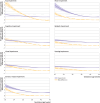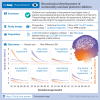Neurological development in children born moderately or late preterm: national cohort study
- PMID: 38267070
- PMCID: PMC11957549
- DOI: 10.1136/bmj-2023-075630
Neurological development in children born moderately or late preterm: national cohort study
Abstract
Objective: To assess long term neurodevelopmental outcomes of children born at different gestational ages, particularly 32-33 weeks (moderately preterm) and 34-36 weeks (late preterm), compared with 39-40 weeks (full term).
Design: Nationwide cohort study.
Setting: Sweden.
Participants: 1 281 690 liveborn singleton children without congenital malformations born at 32+0 to 41+6 weeks between 1998 and 2012.
Main outcome measures: The primary outcomes of interest were motor, cognitive, epileptic, hearing, and visual impairments and a composite of any neurodevelopmental impairment, diagnosed up to age 16 years. Hazard ratios and 95% confidence intervals were estimated using Cox regression adjusted for parental and infant characteristics in the study population and in the subset of full siblings. Risk differences were also estimated to assess the absolute risk of neurodevelopmental impairment.
Results: During a median follow-up of 13.1 years (interquartile range 9.5-15.9 years), 75 311 (47.8 per 10 000 person years) liveborn singleton infants without congenital malformations had at least one diagnosis of any neurodevelopmental impairment: 5899 (3.6 per 10 000 person years) had motor impairment, 27 371 (17.0 per 10 000 person years) cognitive impairment, 11 870 (7.3 per 10 000 person years) epileptic impairment, 19 700 (12.2 per 10 000 person years) visual impairment, and 20 393 (12.6 per 10 000 person years) hearing impairment. Children born moderately or late preterm, compared with those born full term, showed higher risks for any impairment (hazard ratio 1.73 (95% confidence interval 1.60 to 1.87) and 1.30 (1.26 to 1.35); risk difference 4.75% (95% confidence interval 3.88% to 5.60%) and 2.03% (1.75% to 2.35%), respectively) as well as motor, cognitive, epileptic, visual, and hearing impairments. Risks for neurodevelopmental impairments appeared highest from 32 weeks (the earliest gestational age), gradually declined until 41 weeks, and were also higher at 37-38 weeks (early term) compared with 39-40 weeks. In the sibling comparison analysis (n=349 108), most associations remained stable except for gestational age and epileptic and hearing impairments, where no association was observed; for children born early term the risk was only higher for cognitive impairment compared with those born full term.
Conclusions: The findings of this study suggest that children born moderately or late preterm have higher risks of adverse neurodevelopmental outcomes. The risks should not be underestimated as these children comprise the largest proportion of children born preterm. The findings may help professionals and families achieve a better risk assessment and follow-up.
© Author(s) (or their employer(s)) 2019. Re-use permitted under CC BY. No commercial re-use. See rights and permissions. Published by BMJ.
Conflict of interest statement
Competing interests: All authors have completed the ICMJE uniform disclosure form at www.icmje.org/disclosure-of-interest/ and declare: support from Karolinska Institutet Research Foundation grants, 100 Talents Plan Foundation of Sun Yat-sen University, Region Stockholm (clinical postdoctoral appointment), the Swedish Research Council, and the Strategic Research Program in Epidemiology at Karolinska Institutet; SJ is founder and CEO of Neobiomics (EU-VAT number SE559072218601). Neobiomics is a company providing dietary supplement solutions for infants.
Figures


References
MeSH terms
LinkOut - more resources
Full Text Sources
